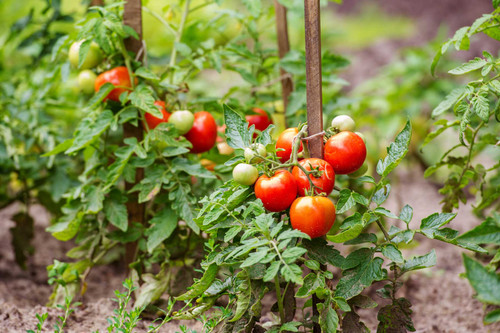Tomato diseases & prevention
Posted by Eli on 26th Jul 2019
Disease can clear the whole tomato crop quickly. Here are some of the common ones and ways to prevent them:
Early blight, a fungal disease, is a common problem among tomato growers. The first signs of trouble appear on the lower leaves as small brown spots with concentric rings in their centers and yellow margins. Affected leaves eventually turn yellow and fall from the plant. Fruits may also be affected. Warm, humid weather favors the spread of this disease.
To help keep early blight in check, clean up all tomato plant remains at the end of the season -- disease-causing spores can survive over the winter or rainy season on plant debris. Mulch plants to reduce splashing spore-carrying soil onto leaves during rains, avoid wetting the foliage when you water, and make sure there's good air circulation around plants by not crowding them.
Late blight is another fungal disease that affects tomatoes as early blight. Leaves develop bluish gray spots, then turn brown and drop. Fruits develop dark brown, corky spots.
To control late blight, avoid wetting the foliage when you water and clean up tomato plant debris in the garden at the end of the season.
Leaf spot can be caused by several different kinds of fungi. It's often a problem that have warm, moist weather. Septoria leaf spot and gray leaf spot is among the most common ones. Septoria begins with many small brown spots with black specks in their centers; older leaves are affected first. Eventually infected leaves turn yellow and drop. Gray leaf spot is similar, except that the spots have gray centers.
The fungi that cause these diseases live on old tomato plant debris in the soil and nearby perennial weeds. Rotating crops from one spot to another in the garden each year is one way to keep this disease in check. Clean up the garden well at the end of the season and avoid overhead watering.
Wilt diseases: Verticillium and fusarium wilts are two troublesome soilborne diseases for which there is no cure. Fusarium causes yellowing of the leaves, wilting and early death of the plant. Verticillium causes similar symptoms, but seldom kills tomato plants. Growth slows down, plants lose leaves and fruits may develop sunscald because of poor foliage cover. The best prevention is to grow verticillium- and fusarium-resistant varieties.
Tips on Disease Prevention:
Rotate your crop of tomatoes each year to avoid soil-borne diseases. Some serious diseases can live in the soil for several years. Try to wait three years before planting tomatoes where they grew before. Also, avoid planting where potatoes, eggplants or peppers grew the previous season, because some diseases attack all these vegetables and live in the soil from year to year.
Plant resistant varieties. Many tomato varieties are resistant to Verticillium and Fusarium wilts, for instance.
Don't smoke in the garden -- you can infect plants with tobacco mosaic virus, a disease that can really cut down on the harvest. If you smoke, wash your hands with soap and water before handling tomato plants.
Clean up the garden well at the end of the season. Many disease-causing organisms spend the winter in plant debris in the soil. Destroy any obviously infected plant material rather than composting it.
Help is available if you need it. Feel free to contact us, if you need an advice/help with your tomato plants.


